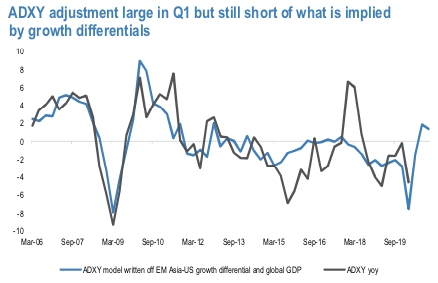While the adjustment in EM Asia FX in Q1 has been meaningful, it still fell short of growth differential-based model predictions (refer 1st chart). ADXY’s 4.5% y/y drop is 3% less than the move implied by EM Asia-US growth gap and the global growth pulse – i.e. a sharp sell-off by itself has not injected unjustified risk premium into Asian FX.
JPM projections of EM Asia’s growth outperformance in Q2 is predicated on the view that the COVID-19 outbreak will have a larger negative impact on services-heavy DM economies. Still, DM capex intentions are unlikely to meaningfully rebound amid such broad economic malaise, which should keep Asian export growth, and by extension Asian FX under pressure (refer 2nd chart).
Central banks around the region are looking to stem the pace of declines in their respective FX rates. Korea recorded a sharp fall in FX reserves in March, with the headline number down just over $9bn. In India the drop has been larger, at closer to $12bn, whilst Thailand is off sharply from the early March peak. There is some buffer though, with central banks within the region generally above the reserve adequacy metric computed by the IMF. The magnitude of the drawdown in FX reserves, particularly in an economy like Thailand, where the central bank has outlined the case for a weaker exchange rate, shows the extent to which capital outflow/current account pressures have intensified. We now expect Thailand to have a BoP deficit in Q1 and this is a key factor for a continued short position in the FX.
IDR has remained under significant pressure. The continued sharp drawdown in foreign bond holdings and a wide current account deficit have been the key drivers of this weakness. This has pushed the IDR REER to more than 10% below its 10 year moving average, while the degree of dislocation with the current account deficit has also been removed. Still, given Q2 seasonals are a headwind for the currency, particularly in May, it is arguably too soon to dive into any fresh long IDR positions. The pace of DNDF issuance has also stabilized over the past month between $6-7bn, which suggests the authorities are not leaning as much against FX weakness as they were through February.
INR has fared better but we believe is further behind from an adjustment stand point. The RBI appears to be mindful of the pace of INR depreciation but we expect the asymmetric intervention bias to persist. The rupee has not caught up with the growth downgrades seen in recent months (refer 3rd chart), whilst equity outflows, on a rolling 6 month basis have only just crossed below the zero bound. The REER also remains elevated to history.
In terms of trading recommendations, we remain long USDTHB and USDTWD as outright trades. TWD can still play catch up with the sizeable equity outflows and reduced imported inflation pressure, while short THB is a play on extended pain in Thailand’s services (tourism) balance.
Finally, we are long a reduced SGD basket to benefit from Singapore’s robust external balance that lends SGD TWI resilience in a global recession, and also the likely end of the MAS easing cycle after this week’s re-centering and slope flattening.
Contemplating above factors consider: 1M At-Expiry-Digital (USDINR >2% OTMS; USDKRW > 2% OTMS; USDSGD > 2% OTMS) call @ 2.8/4.8% indicative.
1M ATMS worst-of basket USD ATM call on (USDINR, USDKRW, USDSGD) @ 0.225/0.275% indicative. Courtesy: JPM



 FxWirePro- Gold Dailty Outlook
FxWirePro- Gold Dailty Outlook  Our laser technique can tell apart elephant and mammoth ivory – here’s how it may disrupt the ivory trade
Our laser technique can tell apart elephant and mammoth ivory – here’s how it may disrupt the ivory trade  FxWirePro- Gold Daily Outlook
FxWirePro- Gold Daily Outlook  Senate approves nearly $61B of Ukraine foreign aid − here’s why it helps the US to keep funding Ukraine
Senate approves nearly $61B of Ukraine foreign aid − here’s why it helps the US to keep funding Ukraine  UK smoking ban would have many benefits for public health – but only if it’s effectively implemented
UK smoking ban would have many benefits for public health – but only if it’s effectively implemented  What is ‘techno-optimism’?
What is ‘techno-optimism’?  AI-powered ‘deep medicine’ could transform healthcare in the NHS and reconnect staff with their patients
AI-powered ‘deep medicine’ could transform healthcare in the NHS and reconnect staff with their patients  FxWirePro- Gold Daily Outlook
FxWirePro- Gold Daily Outlook  Sugar gums have a reputation as risky branch-droppers but they’re important to bees, parrots and possums
Sugar gums have a reputation as risky branch-droppers but they’re important to bees, parrots and possums  FxWirePro-Gold Daily Outlook
FxWirePro-Gold Daily Outlook  FxWirePro- Gold Daily Outlook
FxWirePro- Gold Daily Outlook  Family farms are fast disappearing: our research shows how young generations can take them up successfully
Family farms are fast disappearing: our research shows how young generations can take them up successfully 































